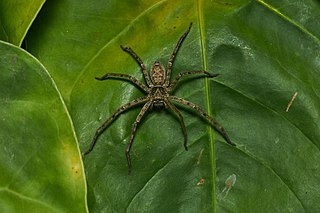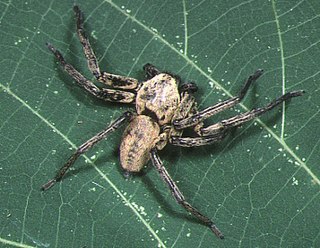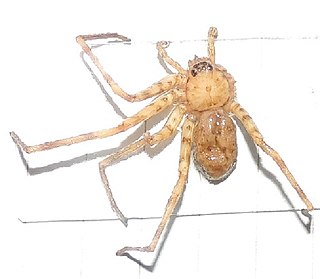
Huntsman spiders, members of the family Sparassidae, are known by this name because of their speed and mode of hunting. They are also called giant crab spiders because of their size and appearance. Larger species sometimes are referred to as wood spiders, because of their preference for woody places. In southern Africa the genus Palystes are known as rain spiders or lizard-eating spiders. Commonly, they are confused with baboon spiders from the Mygalomorphae infraorder, which are not closely related.

Heteropoda venatoria is a species of spider in the family Sparassidae, the huntsman spiders. It is native to the tropical regions of the world, and it is present in some subtropical areas as an introduced species. Its common names include giant crab spider, pantropical huntsman spider or cane spider.

Micrommata virescens, common name green huntsman spider, is a species of huntsman spiders belonging to the family Sparassidae.

Thelcticopis is a genus of huntsman spiders that occurs almost exclusively in the area India to Japan to New Guinea and Fiji. However, one species occurs in Costa Rica, and another in Congo basin, although the latter species is probably misplaced in this genus.
Sparbambus is a genus of jumping spiders containing the two species, Sparbambus gombakensis and Sparbambus sindhudurg. It was first described by J. X. Zhang, J. R. W. Woon & D. Q. Li in 2006, and is found in China,India and Malaysia. They are similar to members of Wanlessia. The name is derived from the Indian bambu, referring to the habitat where the species was initially found. The prefix spar denotes that the genus is in the subfamily Spartaeinae. The two species name refers to the type localities, the Ulu Gombak Malaysia and Sindhudurg Maharashtra, India.

The giant huntsman spider is a species of the huntsman spider family Sparassidae found in Laos. It is considered the world's largest spider by leg span, which can reach up to 30 cm (1 ft).

Thelcticopis severa is a species of huntsman spider found in China, Laos, Korea, and Japan. It is the type species for the genus Thelcticopis, and was first described by Charles Athanase Walckenaer in 1875.
David B. Hirst is an arachnologist previously based at the South Australian Museum in Adelaide. He left the Museum on 22 February 2011. He has described more than 40 species and genera in the huntsman spider family, Sparassidae, and was regularly called on by New Zealand authorities to identify huntsman spiders that entered their country.
Pleorotus was a monotypic genus of Seychelloise huntsman spiders containing the single species, Pleorotus braueri. It was first described by Eugène Louis Simon in 1898, and was endemic to the Seychelles. The description was based on a single male collected on Mahe Island in 1894, but none have been found in later collections, and it has been declared extinct.
Troglohyphantes vignai is a species of cave spider of the family Linyphiidae. It is endemic to Italy.
Olios ceylonicus is a species of spider of the genus Olios. It is endemic to Sri Lanka. It is part of the huntsman spider family Sparassidae.

Spariolenus is a genus of Asian huntsman spiders that was first described by Eugène Louis Simon in 1880. They are found in the Middle East reaching 15-16cm.
Eriovixia gryffindori is a species of spider in the family Araneidae.
Rhacocnemis is a monotypic genus of Seychelloise huntsman spiders containing the single species, Rhacocnemis guttatus. It was first described by Eugène Louis Simon in 1897, and is endemic to the Seychelles.
Paraplectana rajashree is a species of ladybird-mimicking spider described in 2015 from the Western Ghats of Karnataka, India.
Cyrtarachne sunjoymongai is a species of orb-weaver spider from the forests of the Western Ghats of Karnataka, India. It was first formally named in 2015, after naturalist and photographer Sunjoy Monga.
Extraordinarius is a genus of South American huntsman spiders. It was first described by C. A. Rheims in 2019, and it has only been found in Brazil.

Phintella platnicki is a species of jumping spider from southern India.

Marengo batheryensis is a species of jumping spider endemic to India.
Austrarchaea andersoni is a species of assassin spider in the family Archaeidae. It is endemic to Queensland, where it is found in the Conway National Park.








